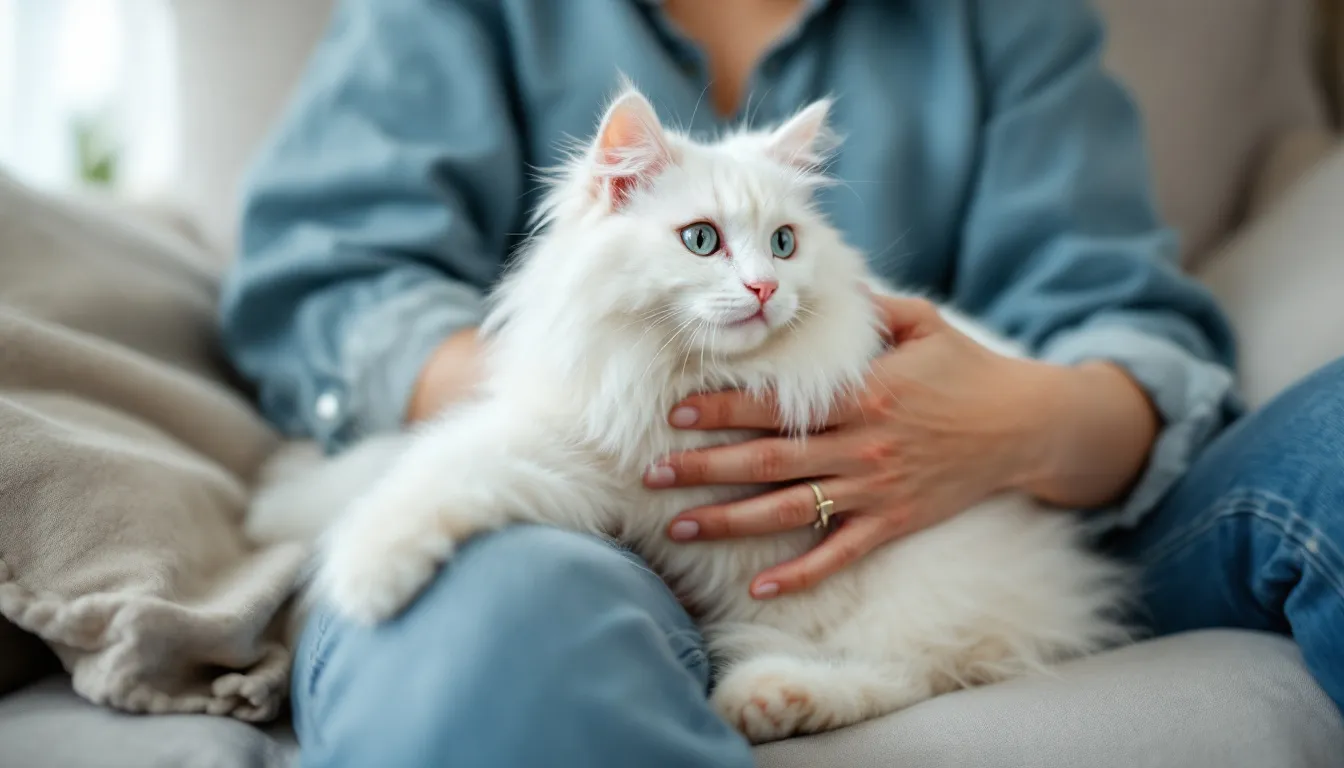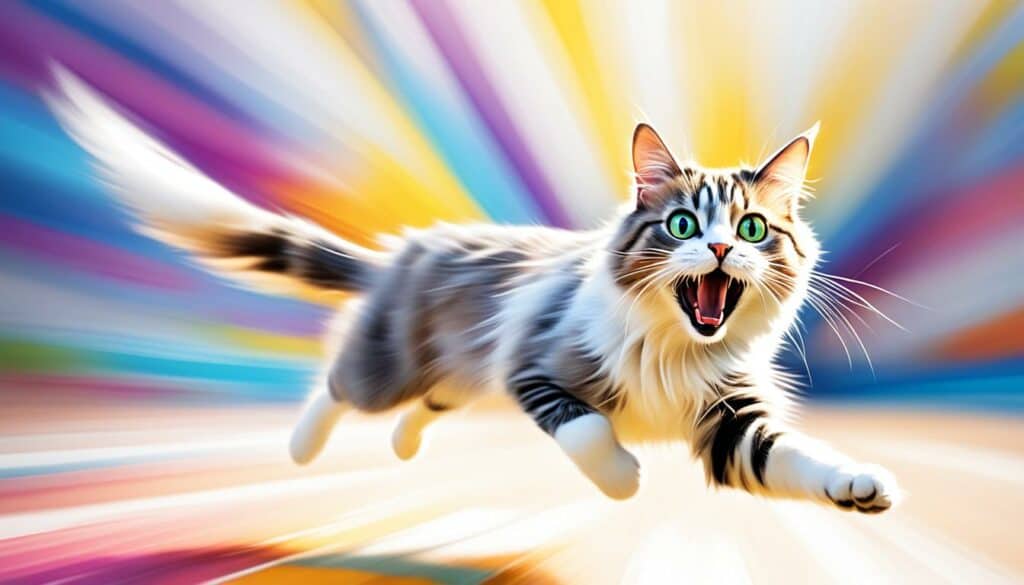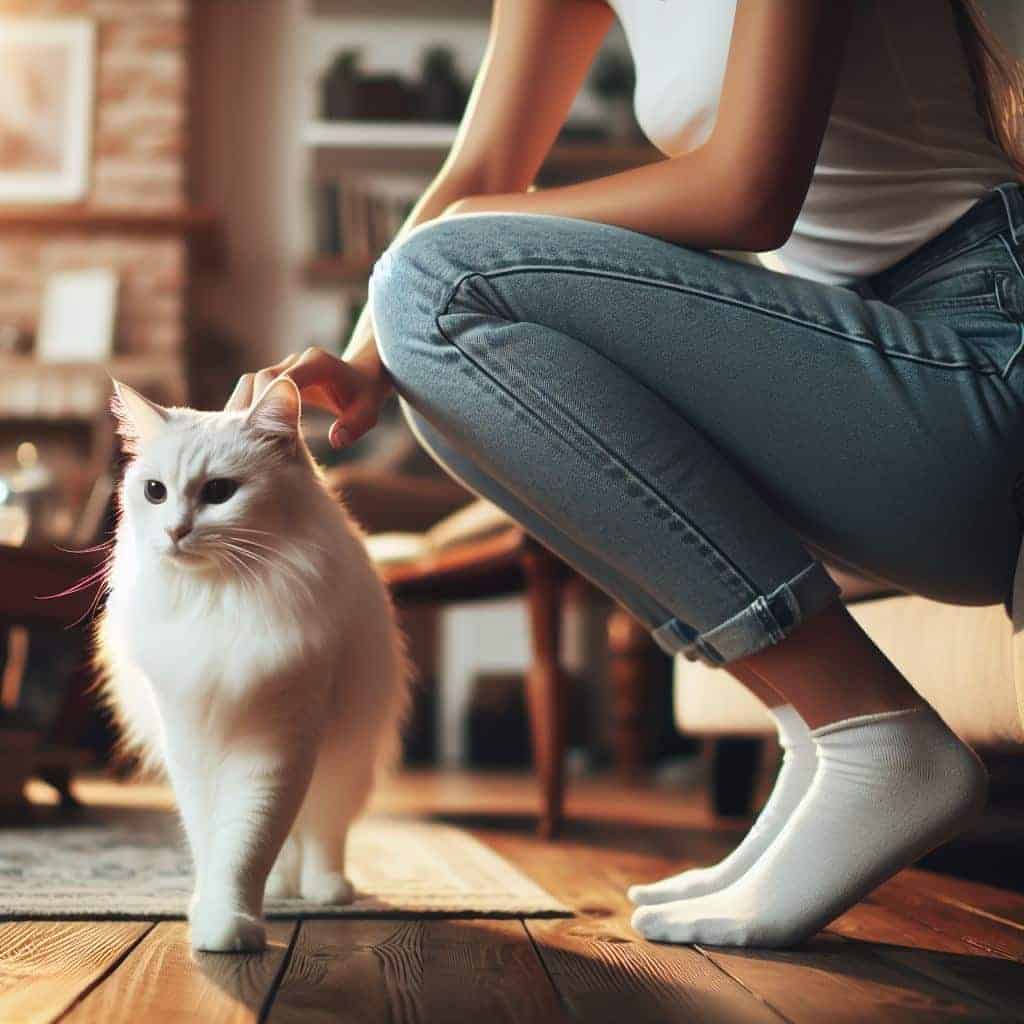
Have you ever wondered why do cats vibrate on you? This curious behavior, often seen when a cat purrs, fascinates many cat owners. When your feline friend curls up on your lap and starts vibrating, it might seem like a simple act of affection. However, there’s more to it.
Cats purr for various reasons, including self-soothing and communication. The vibrations from purring can have therapeutic effects, benefiting both cats and humans.
Understanding why do cats vibrate on you can deepen the bond between you and your furry companion. So, next time your cat starts vibrating, know it’s more than just a sign of contentment.
Reason 1: Contentment and Happiness
I often find myself captivated by the gentle hum of a cat’s purr. It’s like a soothing lullaby that wraps around you, whispering tales of comfort and peace.
But why do cats purr? Let’s dive into this fascinating world of feline behavior.
Science Behind This
Purring is more than just a cute sound. It’s a complex biological process. When cats purr, they release serotonin, often called the “happy hormone.” This release has positive effects on their neurological processes, making them feel good.
The vibrations from purring can also calm their body, helping them relax and feel at ease.
Supporting Stats
Statistics show that cats purr frequently when they are content. In fact, studies suggest that cats purr at a frequency of 25 to 150 Hertz, which is known to promote healing and reduce pain. This frequency range is not only beneficial for cats but also has therapeutic effects on humans.
|
Frequency (Hertz) |
Effect on Cats |
Effect on Humans |
|---|---|---|
|
25-50 |
Healing |
Stress Reduction |
|
50-100 |
Pain Relief |
Lower Blood Pressure |
|
100-150 |
Calming |
Improved Mood |
Does This Apply to All Cats?
You might wonder if all cats purr when they’re happy. The truth is, not every cat will purr in the same way or for the same reasons. While many cats vibrate with contentment, some may remain silent even when they’re feeling good. Each feline has its unique way of expressing emotions.
Some cats may purr loudly, while others might have a softer, almost inaudible purr.
Understanding your cat’s behavior can help you recognize these differences. For instance, some cats may purr when they’re anxious or in pain, using the vibrations as a self-soothing mechanism. This doesn’t mean they’re unhappy; it’s just their way of coping.
Cats may purr when they’re scared or stressed, and this can be a sign that they need comfort or reassurance.
Interestingly, studies have shown that the frequency of a cat’s purr can have healing properties. The vibrations can help reduce inflammation and act as a form of pain relief.
So, even if your desk cat doesn’t purr when happy, it might still use this behavior for other beneficial reasons.
What Else to Know
When it comes to understanding your desk cat’s behavior, there’s always more to learn. Cats communicate through a variety of signals, including body language and vocalizations.
Observing your cat’s body language can provide insights into their mood and needs. For example, a relaxed posture and slow blinking often indicate a calm and content cat.
Your desk cat nest might also play a role in their purring behavior. A comfortable and secure environment, like a cozy desk cat bed, can encourage your feline friend to relax and express their happiness through purring.
Providing a safe space for your cat can enhance their overall well-being and strengthen your bond.
Reason 2: Communication
Have you ever wondered why your desk cat purrs when you walk into the room? This behavior is more than just a sign of contentment. Cats use purring as a form of communication, conveying messages to their human companions and other animals.
Understanding this aspect of your feline friend’s behavior can deepen your bond and help you respond to their needs more effectively.
Science Behind This
Cats have developed purring as a versatile communication tool. When your desk cat purrs, it might be saying, “I’m happy to see you,” or even “I need something.” The vibrations produced during purring can vary in frequency and intensity, each serving a different purpose.
For instance, a cat might purr at a higher frequency when it’s hungry, signaling to you that it’s time for a meal. This ability to communicate through purring has evolved over time, offering cats a selective advantage in both domestic and wild environments.
Supporting Stats
Research shows that cats use purring in various social interactions. A study found that cats often purr when they are being fed or when they want attention from their owners. This behavior is not just limited to domestic cats; many wild felines also use similar vocalizations to communicate with their young or other members of their species.
Here’s a quick look at how cats use purring in different contexts:
|
Context |
Frequency of Purring |
Purpose |
|---|---|---|
|
Feeding Time |
High |
Request for food |
|
Social Interaction |
Moderate |
Bonding with humans |
|
Nursing Kittens |
Low |
Comfort and reassurance |
|
Stressful Situations |
Variable |
Self-soothing mechanism |
Does This Apply to All Cats?
You might wonder if every cat uses purring as a communication tool. The truth is, not all cats express themselves in the same way. While many cats vibrate with contentment, others might use different methods to convey their feelings.
Some cats, like your desk cat, may purr loudly when they’re happy or seeking attention. Others might have a softer purr or even remain silent.
Cats have unique personalities, and their communication styles can vary widely. For instance, some cats might purr when they’re hungry, while others might meow or rub against you. Understanding these variations can help you better interpret your feline friend’s needs.
Pay attention to your cat’s body language and vocalizations to get a clearer picture of what they’re trying to tell you.
What Else to Know
Besides purring, cats have several other ways to communicate with humans. Your desk cat might use a combination of vocalizations, body language, and behaviors to express itself. Here are a few common methods:
-
Meowing: Cats often meow to get your attention or express a need. The tone and frequency can vary depending on what they’re trying to communicate.
-
Tail Movements: A cat’s tail can tell you a lot about its mood. A raised tail often indicates happiness, while a flicking tail might signal irritation.
-
Ear Position: Cats use their ears to express emotions. Forward-facing ears usually mean curiosity or interest, while flattened ears can indicate fear or aggression.
-
Rubbing and Head-Butting: When your desk cat rubs against you or gives you a gentle head-butt, it’s marking you with its scent, a sign of affection and trust.
Understanding these signals can enhance your relationship with your cat. By recognizing and responding to your cat’s communication methods, you can create a more harmonious living environment.
Remember, each cat is unique, and learning to interpret their behavior takes time and patience.
Reason 3: Healing and Self-Soothing
I remember the first time I noticed my cat, Doofy, purring softly while nursing a small injury. It was as if he had his own built-in healing mechanism.
This BEHAVIOR intrigued me, and I soon discovered that cats purr to calm themselves and promote healing. The gentle vibrations of a cat’s purr can have remarkable effects on their well-being.
Science Behind This
Purring isn’t just a sign of contentment; it has remarkable healing properties. When cats purr, they produce vibrations at frequencies between 25 and 150 Hertz. These vibrations can promote healing and reduce pain.
Studies have shown that these frequencies can decrease blood pressure, alleviate stress, and aid in the healing process. Cats use purring as a self-soothing mechanism, helping them manage pain and tension. This natural ability allows them to recover more quickly from injuries or stressful situations.
Supporting Stats
Research highlights the therapeutic effects of purring on both cats and humans. Here’s a closer look at how these vibrations work:
|
Frequency (Hertz) |
Effect on Cats |
Effect on Humans |
|---|---|---|
|
25-50 |
Bone Healing |
Stress Reduction |
|
50-100 |
Pain Relief |
Lower Blood Pressure |
|
100-150 |
Muscle Repair |
Improved Mood |
|
150+ |
Calming Effect |
Enhanced Relaxation |
These findings underscore the importance of purring as a natural healing tool for cats. By understanding these effects, you can better appreciate why your desk cat might purr even when it’s not feeling its best.
Does This Apply to All Cats?
Have you ever wondered if all cats use purring as a self-soothing mechanism? While many cats do, not every feline will purr in the same way or for the same reasons. Each cat has its unique personality and behavior, which means their purring can vary significantly.
Cats purr not only when they’re happy but also when they need to manage stress or discomfort. This behavior serves as a natural way for them to soothe tension and ease breathing. The vibrations produced during purring can have a calming effect on their body, helping them cope with challenging situations.
It’s fascinating how these gentle creatures have evolved to use purring as a tool for self-healing and communication.
Understanding your cat’s unique behavior can help you provide better care and support. By observing how your cat responds to different situations, you can gain insights into their needs and emotions.
This knowledge allows you to create a more comfortable and nurturing environment for your furry friend.
What Else to Know
Purring offers several additional benefits for cats beyond self-soothing. These gentle vibrations can promote healing and reduce pain, making them an essential part of a cat’s natural recovery process.
Studies have shown that purring can decrease blood pressure and alleviate stress, not only for cats but also for humans who share their lives with these delightful creatures.
Here’s a quick look at some of the benefits of purring:
|
Benefit |
Effect on Cats |
Effect on Humans |
|---|---|---|
|
Stress Reduction |
Calming Effect |
Lower Blood Pressure |
|
Pain Relief |
Eases Discomfort |
Promotes Relaxation |
|
Healing Properties |
Aids Recovery |
Enhances Well-being |
|
Emotional Bonding |
Strengthens Connection |
Improves Mood |
These benefits highlight the importance of purring as a multifaceted tool for cats. By understanding these effects, you can better appreciate why your cat might purr in various situations.
Reason 4: Bonding with Humans

Have you ever felt a deep connection with your cat when it curls up on your lap and starts purring? This soothing sound isn’t just a sign of contentment; it’s a powerful tool for bonding.
Cats have an incredible ability to form strong emotional connections with their human companions, and purring plays a significant role in this process.
Science Behind This
When cats purr, they create vibrations that resonate not only within their own bodies but also with yours. This vibration can have a calming effect, reducing stress and promoting relaxation.
The act of purring releases endorphins in both cats and humans, enhancing feelings of happiness and well-being. This mutual benefit strengthens the bond between you and your feline friend, creating a sense of trust and affection.
Supporting Stats
Studies have shown that the frequency of a cat’s purr, typically between 25 and 150 Hertz, can have therapeutic effects on humans. This range is known to promote healing, reduce pain, and lower blood pressure.
Here’s a look at how these frequencies impact both cats and humans:
|
Frequency (Hertz) |
Effect on Cats |
Effect on Humans |
|---|---|---|
|
25-50 |
Stress Reduction |
Lower Blood Pressure |
|
50-100 |
Pain Relief |
Enhanced Relaxation |
|
100-150 |
Emotional Bonding |
Improved Mood |
|
150+ |
Calming Effect |
Increased Happiness |
These findings highlight the unique role that purring plays in fostering a strong bond between cats and their human companions.
Does This Apply to All Cats?
You might wonder if every cat uses purring as a bonding tool. The truth is, not all cats express themselves in the same way. While many cats vibrate with contentment, others might use different methods to convey their feelings.
Some cats, like your desk cat, may purr loudly when they’re happy or seeking attention. Others might have a softer purr or even remain silent.
Cats have unique personalities, and their communication styles can vary widely. For instance, some cats might purr when they’re hungry, while others might meow or rub against you. Understanding these variations can help you better interpret your feline friend’s needs.
Pay attention to your cat’s body language and vocalizations to get a clearer picture of what they’re trying to tell you.
What Else to Know
Besides purring, cats have several other ways to communicate with humans. Your desk cat might use a combination of vocalizations, body language, and behaviors to express itself. Here are a few common methods:
-
Meowing: Cats often meow to get your attention or express a need. The tone and frequency can vary depending on what they’re trying to communicate.
-
Tail Movements: A cat’s tail can tell you a lot about its mood. A raised tail often indicates happiness, while a flicking tail might signal irritation.
-
Ear Position: Cats use their ears to express emotions. Forward-facing ears usually mean curiosity or interest, while flattened ears can indicate fear or aggression.
-
Rubbing and Head-Butting: When your desk cat rubs against you or gives you a gentle head-butt, it’s marking you with its scent, a sign of affection and trust.
Understanding these signals can enhance your relationship with your cat. By recognizing and responding to your cat’s communication methods, you can create a more harmonious living environment.
Reason 5: Hunger or Request for Attention
Have you ever noticed your cat purring loudly when it’s near mealtime? This behavior might seem like a simple expression of contentment, but it often signals a request for food or attention.
Cats have a unique way of communicating their needs, and understanding these signals can help you respond more effectively to your feline friend’s requests.
Science Behind This
Cats use purring as a versatile communication tool. When your cat purrs, it might be trying to tell you something important. The vibrations produced during purring can vary in frequency and intensity, each serving a different purpose.
For instance, a cat might purr at a higher frequency when it’s hungry, signaling to you that it’s time for a meal. This ability to communicate through purring has evolved over time, offering cats a selective advantage in both domestic and wild environments.
Supporting Stats
Research shows that cats use purring in various social interactions. A study found that cats often purr when they are being fed or when they want attention from their owners.
This behavior is not just limited to domestic cats; many wild felines also use similar vocalizations to communicate with their young or other members of their species.
Here’s a quick look at how cats use purring in different contexts:
|
Context |
Frequency of Purring |
Purpose |
|---|---|---|
|
Feeding Time |
High |
Request for food |
|
Social Interaction |
Moderate |
Bonding with humans |
|
Nursing Kittens |
Low |
Comfort and reassurance |
|
Stressful Situations |
Variable |
Self-soothing mechanism |
Does This Apply to All Cats?
Not every cat expresses its needs in the same way. Just like humans, cats have unique personalities and preferences. Others might use different methods to communicate their needs.
For instance, some cats may meow persistently, while others might rub against your legs or follow you around the house. Observing your cat’s body language and vocalizations can provide valuable insights into their needs and emotions.
What Else to Know
Cats have a variety of ways to request attention beyond purring. Recognizing these signals can help you respond more effectively to your feline friend’s needs.
Here are some common behaviors cats use to communicate:
-
Meowing: Cats often meow to express a need or desire. The tone and frequency can vary, indicating different messages.
-
Tail Movements: A cat’s tail can reveal a lot about its mood. A raised tail usually signifies happiness, while a flicking tail might indicate irritation.
-
Ear Position: Cats use their ears to convey emotions. Forward-facing ears often mean curiosity, while flattened ears can signal fear or aggression.
-
Rubbing and Head-Butting: When your cat rubs against you or gives a gentle head-butt, it’s marking you with its scent, a sign of affection and trust.
Reason 6: Habitual Behavior
Have you ever noticed your cat purring at the most unexpected times? Maybe she’s just lounging on the windowsill or watching the world go by. This might seem puzzling, but it often comes down to habitual behavior.
Cats, like many creatures, develop habits that become part of their daily routine. Understanding this can help you appreciate the nuances of your feline friend’s actions.
Science Behind This
Purring can become a habitual action for cats. Over time, they may start purring in specific situations simply because it’s become a routine. This behavior often begins in kittenhood.
Kittens learn to purr when they’re nursing, which is a comforting and bonding experience with their mother. As they grow, this purring can extend to other parts of their life, becoming a habitual response to various stimuli.
The act of purring involves the rapid movement of the laryngeal muscles, creating vibrations that resonate throughout the cat’s body.
This process can become second nature, much like how humans might hum a tune without thinking. For cats, purring can be a way to self-soothe, communicate, or simply express contentment.
Supporting Stats
Research into feline behavior shows that habitual actions are common among cats. Here’s a look at some statistics that highlight this:
|
Behavior Type |
Percentage of Cats Exhibiting |
Common Triggers |
|---|---|---|
|
Purring Habitually |
70% |
Relaxation, Routine |
|
Grooming Rituals |
85% |
After Meals, Before Sleep |
|
Play Patterns |
60% |
Morning, Evening |
|
Sleeping Habits |
90% |
Daytime, Nighttime |
These statistics illustrate how ingrained certain behaviors can become in a cat’s daily life. Understanding these patterns can help you better interpret your cat’s actions and provide a more enriching environment.
Does This Apply to All Cats?
Have you ever wondered if all cats share the same habitual behaviors as your beloved feline? While many cats exhibit similar patterns, each feline has its own unique quirks and routines.
Just like humans, cats develop habits based on their environment, experiences, and individual personalities. Some cats might purr habitually when they find a cozy spot, while others might reserve their purring for specific moments of contentment or stress relief.
Cats often purr as a form of self-soothing, especially when they’re nervous or in pain. This behavior can vary widely among different cats.
Understanding these differences can help you better appreciate your cat’s unique personality.
What Else to Know
Cats have a fascinating array of habitual actions beyond purring. These behaviors often serve as coping mechanisms or ways to communicate with their human companions.
Here are some common habitual actions you might notice in your cat:
-
Grooming Rituals: Many cats develop specific grooming routines, often after meals or before sleep. This behavior helps them relax and maintain their hygiene.
-
Play Patterns: Cats often have set times for play, usually in the morning or evening. Engaging in play during these periods can help satisfy their natural instincts and provide mental stimulation.
-
Sleeping Habits: Cats are known for their love of sleep, often napping throughout the day. Understanding your cat’s sleep patterns can help you create a comfortable resting environment.
-
Exploration and Curiosity: Some cats have a habit of exploring their surroundings, investigating new objects or changes in their environment. This behavior is a sign of their natural curiosity and intelligence.
Understanding why your cat vibrates on you can deepen your connection with them.
Cats purr for various reasons, from expressing happiness to self-soothing. Doofy, like many cats, uses purring as a way to communicate and bond. By observing your cat’s behavior, you can learn more about their needs and emotions. This knowledge not only enhances your relationship but also contributes to their well-being.
Remember, each cat is unique, and their purring can offer insights into their world. Embrace these moments and cherish the special bond you share with your feline friend.

In her previous life, Lisa traveled extensively, both for work and leisure. After the pandemic struck, Lisa locked up her luggage and adopted a cat ever since.
Lisa is now an avid cat lover, she devotes most of her free time serving as butler to her adorable feline at home. When she is not with her cat, she can be seen using her phone sourcing for the latest cat supplies online.


